Slaying the paper monster
Think of Heather Burke as an organizational superhero. She owns the
Ottawa-based Smart Space Organizing and is a member of Professional
Organizers in Canada. In short, she's a trained professional organizer who can
turn your desk's papery hell into a neat and tidy haven.
Burke said many students fall into one of two categories: pilers or filers. "If you've got piles of paper around, or your inbox is full of stuff, that generally reflects that you're a piler," she said.
One way to combat piler-ism is to keep all electronic and paper files named and colour-coded consistently — and to keep it all neat. "At the end of the day, clear away your desktop and email," said Burke. She also recommended preparing a task list for the next day to allocate specific chunks of time for each activity.
Another way to keep things neat and tidy is to use some organizational tools, easily purchased at Staples or the campus bookstore.
Literature Sorter
$20.93
"The literature sorter is great for pilers," enthused Burke. "Rather than having piles on your desk, it has a place for each of your piles." Each slot holds approximately a month to six weeks' worth of notes. When the slot is full, it's time to go through and decide what can be kept, stored or tossed. "When you go to write an exam or a paper, your notes are right there, not all over the room."
Wall-Mounted File Holders
$11.39 each, $25.32 for a pack of three
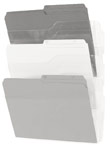
Burke recommended prioritizing paperwork using wall-mounted sorters. She uses them for items that must be read immediately, action files used on a daily basis, reference files used often but not every day and other papers that need to be filed. She said you can also organize by subject. "It looks messy, but it's not meant to be pretty, it's meant to be useful," she explained. She recommended mounting these behind a door so they can be easily hidden during social times.
Coloured Hanging Files
$10.75
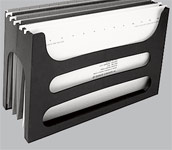
Burke recommended using either colourful folders or coloured tabs to keep notes organized. She suggested using one colour for each class, keeping that colour consistent from paper and email folders to binders and the highlighters used in the notes. She also recommended using tabs to organize within the folders — for example, the tab on the left denotes the class, while the tabs on the right sort papers into class notes, study notes, assignments and exams.
Magazine Holder
$9.55 for two
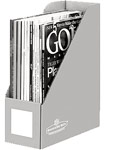
Burke suggested using magazine holders to store older notes neatly in a bookcase or on a shelf. These can be colour-coded and tabbed as well, to help you sort through older notes quickly and easily.
Pocket Folder
$1.59
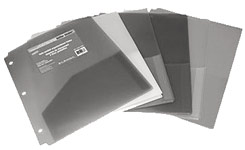
Study notes aren't the only things that need to be organized; "Paper management is also looking after all the receipts and knowing expenses," said Burke. "Some people use a pocket file folder to file receipts on a monthly basis ... and label (each file) so you know what's in there." You can also buy three-hole-punched pocket files so they can be neatly stored in a binder.
Portable File Box
$19.56
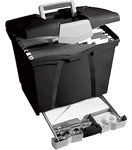
Burke highly recommended the portable file box — which has space for hanging files, extra paper and other supplies — "Especially if you're moving from place to place to study!"
Post-it Notes
$10.99 for a pack of five
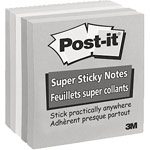
Sometimes, the simplest tools are the most effective. "(Post-its) are a major organizing tool," said Mark Hauge, general manager of Staples. "You can use them for study purposes." Post-its come in so many hues; they will definitely fit into your colour-coding scheme.
Shredder
$68.92 and up
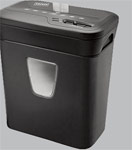
Haug advised students buy shredders to dispose of all papers. "Identity theft is a really big concern, and it's not going to go away." He recommended shredding any papers or mail with your name on it — these papers may contain identifying information that could be used against you.
Organizational tools won't do you any good if they're stuffed with useless papers. "Get in the habit of purging regularly for notes you don't need," recommended Burke. "When you get a piece of paper, email or note, ask yourself to make some decisions: do I need to keep it? Do I have to act on it, or do I just need to file it?" She recommended students use the RAFT system for each paper they come across: Read, Act, File or Toss.
Above all, Burke stressed high visibility and easy accessibility. "Rather than making the student try to fit a system, we try to make a system that works for the student." Try a few different systems to see which organizational tools and styles work best to quash your paper colossus.
All pictures are from Staples.
Burke said many students fall into one of two categories: pilers or filers. "If you've got piles of paper around, or your inbox is full of stuff, that generally reflects that you're a piler," she said.
One way to combat piler-ism is to keep all electronic and paper files named and colour-coded consistently — and to keep it all neat. "At the end of the day, clear away your desktop and email," said Burke. She also recommended preparing a task list for the next day to allocate specific chunks of time for each activity.
Another way to keep things neat and tidy is to use some organizational tools, easily purchased at Staples or the campus bookstore.
Literature Sorter
$20.93

"The literature sorter is great for pilers," enthused Burke. "Rather than having piles on your desk, it has a place for each of your piles." Each slot holds approximately a month to six weeks' worth of notes. When the slot is full, it's time to go through and decide what can be kept, stored or tossed. "When you go to write an exam or a paper, your notes are right there, not all over the room."
Wall-Mounted File Holders
$11.39 each, $25.32 for a pack of three

Burke recommended prioritizing paperwork using wall-mounted sorters. She uses them for items that must be read immediately, action files used on a daily basis, reference files used often but not every day and other papers that need to be filed. She said you can also organize by subject. "It looks messy, but it's not meant to be pretty, it's meant to be useful," she explained. She recommended mounting these behind a door so they can be easily hidden during social times.
Coloured Hanging Files
$10.75

Burke recommended using either colourful folders or coloured tabs to keep notes organized. She suggested using one colour for each class, keeping that colour consistent from paper and email folders to binders and the highlighters used in the notes. She also recommended using tabs to organize within the folders — for example, the tab on the left denotes the class, while the tabs on the right sort papers into class notes, study notes, assignments and exams.
Magazine Holder
$9.55 for two

Burke suggested using magazine holders to store older notes neatly in a bookcase or on a shelf. These can be colour-coded and tabbed as well, to help you sort through older notes quickly and easily.
Pocket Folder
$1.59

Study notes aren't the only things that need to be organized; "Paper management is also looking after all the receipts and knowing expenses," said Burke. "Some people use a pocket file folder to file receipts on a monthly basis ... and label (each file) so you know what's in there." You can also buy three-hole-punched pocket files so they can be neatly stored in a binder.
Portable File Box
$19.56

Burke highly recommended the portable file box — which has space for hanging files, extra paper and other supplies — "Especially if you're moving from place to place to study!"
Post-it Notes
$10.99 for a pack of five

Sometimes, the simplest tools are the most effective. "(Post-its) are a major organizing tool," said Mark Hauge, general manager of Staples. "You can use them for study purposes." Post-its come in so many hues; they will definitely fit into your colour-coding scheme.
Shredder
$68.92 and up

Haug advised students buy shredders to dispose of all papers. "Identity theft is a really big concern, and it's not going to go away." He recommended shredding any papers or mail with your name on it — these papers may contain identifying information that could be used against you.
Organizational tools won't do you any good if they're stuffed with useless papers. "Get in the habit of purging regularly for notes you don't need," recommended Burke. "When you get a piece of paper, email or note, ask yourself to make some decisions: do I need to keep it? Do I have to act on it, or do I just need to file it?" She recommended students use the RAFT system for each paper they come across: Read, Act, File or Toss.
Above all, Burke stressed high visibility and easy accessibility. "Rather than making the student try to fit a system, we try to make a system that works for the student." Try a few different systems to see which organizational tools and styles work best to quash your paper colossus.
All pictures are from Staples.













